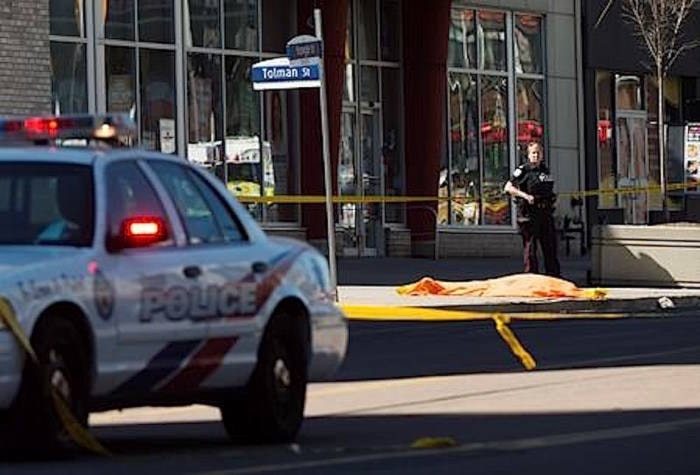Experts say the powerful video of Alek Minassian’s arrest reveals a textbook case of an officer defusing danger through a series of life-and-death choices based on training and a calm mind.
The footage shows an officer who police sources identified as Const. Ken Lam standing up, turning off his siren and talking clearly to the suspect, even as the dead and injured lay along Yonge Street after being struck down by a white rental van.
“This is exactly the type of de-escalation … and response to these types of confrontations that we hope to see,” said Ontario ombudsman Paul Dube.
Lam calmly holstered his service weapon, held up his baton and handcuffed Minassian as he lay on the sidewalk.
“He gave himself the space and time. He assessed the threat and realized he had options other than firing his weapon.”
Dube published a June 2016 report calling for increased police training on defusing dangerous situations after several high-profile deaths of people with mental illnesses who confronted officers.
He said the constable’s actions are a sign that police are gaining from training that includes simulations of tense standoffs with people who are emotionally unstable.
Sammy Yatim’s death in July 2013 in Toronto — where the mentally ill man was shot multiple times as officers surrounded an empty streetcar he was on — helped prompt reforms.
RELATED: Toronto van attack suspect faces 10 counts of first-degree murder
In recent years at least one day has been added to Toronto police in-service training on de-escalation and “dealing with people in crisis,” said Mike McCormack, president of the police union in Toronto.
The program is part of a mandatory three-day training for all officers that incorporates crisis communication, de-escalation and containment measures.
“A major component of this training includes a variety of scenarios that are designed to evaluate officer’s skills in effectively communicating with people in crisis and those who are suffering from a possible mental disorder,” said an email from the union.
Meanwhile, recruits at the Ontario Police College are now receiving more training, as are a number of police forces around the province, though it’s yet to be a provincewide standard, said Dube.
Christian Leuprecht, a professor at Royal Military College in Kingston, Ont., who studies policing and security issues, said Lam’s actions were “textbook” examples of the latest approaches.
The result is a suspect who is now in custody and who may be able to shed light on why the devastating incident occurred, he said.
RELATED: Officer’s actions ‘one shining moment’ in wake of attack
“That particular situation yesterday, the way in which it went down was nothing short of remarkable,” Toronto Police Chief Mark Saunders told a news conference Tuesday.
Saunders said he spoke to Lam, and the officer is doing well and thankful for the public’s support. Lam told him ”he defaulted to his training,” the chief said.
Police say Minassian, 25, of Richmond Hill, Ont., is the lone suspect in the attack. He was charged Tuesday with 10 counts of first-degree murder and 13 counts of attempted murder.
Leuprecht noted how Lam only stood up after carefully observing the suspect and determining he didn’t have a gun.
Lam spoke loudly and calmly, even as the suspect encouraged the officer to shoot him. When he claimed to have a gun in his pocket, Lam replied, “I don’t care,” and repeatedly instructed him to “Get down.”
Leuprecht said Lam seemed to go further than some others might have when he decided to approach and arrest the suspect, rather than wait for backup.
“There’s an impressive moment when he takes his firearm, puts it in his holster, he goes over with his baton, and he handcuffs the individual,” he said.
“I think that goes above and beyond the call of duty. He could have had a knife. He could have had a suicide belt.”
However, the university professor, who is currently teaching in Australia, says if the constable had waited for backup, the situation might have escalated and had a different outcome.
“The opportunity to ensure the individual could no longer pose a chance of harm to himself or to others is what that officer jumped at,” said Leuprecht.
McCormack said while additional training is a factor, he knows Lam well enough to say his personality factored in.
He described him as an intelligent, relatively young officer who is highly skilled and trained.
McCormack says the constable — who is in his 30s — positioned himself well so that he could see precisely what was unfolding before him.
“By his actions he did not perceive the threat to escalate and that is why he did not use his firearm,” he said.
The Canadian Press
